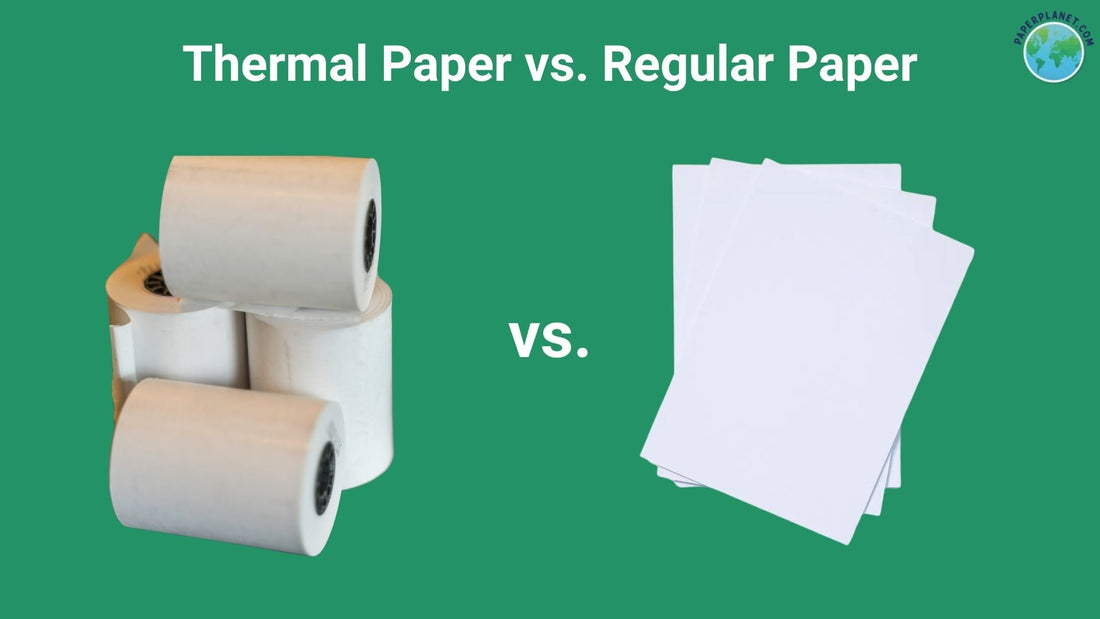Thermal Paper vs. Regular Paper: What’s the Difference?

Choosing between thermal and regular paper isn’t just about cost or convenience. It’s about finding the right fit for your print job. Whether you're running a retail store, shipping hundreds of packages a day, or printing legal documents, the paper you use affects speed, quality, and long-term performance.
Let’s break it down clearly so you can make the best decision based on facts, not guesses.
What Is Thermal Paper?
Thermal paper is a special printing material with a heat-sensitive coating on one side. This coating reacts when heat is applied, turning dark in specific areas to form text or images. This means thermal paper doesn’t need ink, toner, or ribbons. The technology relies entirely on heat, making it faster and simpler for businesses that need quick, one-touch printing.
It’s used in point-of-sale systems, shipping labels, parking tickets, and medical settings. Its coating does the heavy lifting, producing clean and legible results without requiring a full printer setup.
What Is Regular Paper?
Regular paper, offset, uncoated, or plain paper, doesn’t react to heat. It needs ink or toner to display anything on its surface. Printing on regular paper requires a compatible device, usually an inkjet or laser printer. The machine applies ink mechanically or with heat and static.
This paper is ideal for office reports, legal contracts, flyers, newsletters, and books. It comes in different weights, textures, and brightness levels, making it suitable for casual and professional use.
How Thermal Printing Works

Thermal printers don’t use cartridges or toners. Instead, they have thermal print heads that heat specific parts of the coated paper. The paper reacts by changing color in those areas, creating letters or images.
The process is fast, quiet, and low-maintenance. Because no ink is involved, thermal printing is often more reliable for fast-paced environments with high print volumes.
How Regular Printing Works
In regular printing, ink or toner is applied to plain paper through a mechanical or electrostatic process. Inkjet printers spray tiny droplets of liquid ink onto the surface.
Laser printers use static electricity to attract toner powder onto the paper, then apply heat to fuse it in place. This method offers more control over image quality and color, but is usually slower and more complex. It also requires regular maintenance.
Key Differences Between Thermal Paper and Regular Paper
- Printing Technology - Thermal paper uses heat to create an image. Regular paper requires ink or toner.
- Cost Efficiency - Thermal printing can be more cost-effective at scale because there are no ink or toner supplies to maintain.
- Print Durability - Thermal paper can fade with exposure to heat or light. Regular paper holds ink or toner better over time, especially when stored properly.
- Image Quality - Thermal printing offers crisp results for short-term use. Regular paper supports full-color and high-resolution printing for more complex visuals.
- Use Case Suitability - Thermal paper is best for receipts, tickets, and shipping labels, while regular paper is better for forms, reports, and marketing materials.
Advantages of Thermal Paper

You don’t need ink or toner, which reduces supply costs. Printing is quick and quiet, with fewer moving parts that can fail. This makes thermal printers reliable in fast-paced or space-constrained settings. It’s ideal for temporary documents like receipts or barcode labels.
Advantages of Regular Paper
Regular paper offers better retention for long-term storage. It supports colored inks and has many textures, weights, and finishes. It works well for high-quality presentations, internal reports, and archived documents.
When to Use Thermal Paper vs. Regular Paper
Use thermal paper for short-term needs in fast-moving environments like retail, shipping, and healthcare. Use regular paper for anything that requires color, permanence, or a more polished look, such as documents, reports, books, or promotional materials. Match the paper type to the purpose of the print job.
Environmental and Health Factors to Consider
Thermal paper often contains BPA or BPS in its coating. These chemicals can transfer to the skin and pose health concerns, especially with regular contact.
Many manufacturers, like Paper Planet, now offer BPA-free alternatives. Regular paper is generally easier to recycle and doesn’t contain reactive coatings. Both types should be disposed of properly to reduce environmental impact.
Cost Comparison: Which Paper Is More Budget-Friendly?
Thermal printers usually have lower operating costs. You don’t need to buy ink or toner; maintenance is minimal.
For high-volume printing, this adds up to significant savings. While regular paper may have lower paper costs, the cost of ink, toner, and printer upkeep can outweigh that over time.
Your total cost will depend on how often and the type of documents you print.
Paper Planet’s Thermal Paper Solutions
Paper Planet offers a wide range of thermal paper rolls that meet safety and performance standards. All rolls are BPA-free and eco-conscious. They are compatible with leading thermal printer brands and are available in bulk. Paper Planet supports retail, logistics, healthcare, and more businesses with fast delivery and reliable service.
Why Choose Paper Planet for Thermal Paper
Paper Planet provides consistent, quality-tested products that meet your industry standards. Their thermal paper options are BPA-free and made for high-efficiency use. You can also access bulk pricing, precise product specs, and a support team that understands your printing needs.
Conclusion
Thermal and regular paper each serve specific functions. If speed and volume matter, thermal is the better choice. Regular paper is more suitable if you need long-lasting prints with color options. Consider your usage, cost expectations, and print quality needs.
If you need help choosing the right paper, contact Paper Planet. We will match your business needs with the correct thermal paper solution.
FAQs
What’s the main difference between thermal paper and regular paper?
Thermal paper has a heat-sensitive coating that darkens when exposed to a thermal printer’s heated print head, creating text or images without ink, toner, or ribbons. Regular paper requires ink or toner applied by an inkjet or laser printer. Thermal paper is ideal for fast, short-term prints like receipts and labels, while regular paper works best for documents that need color, long-term durability, or high-resolution printing.
Which is more cost-effective for businesses: thermal paper or regular paper?
For high-volume printing, thermal paper is often more cost-efficient because it doesn’t require ink or toner and thermal printers have fewer moving parts, resulting in lower maintenance. Regular paper itself may be inexpensive, but the ongoing costs of ink and printer upkeep can add up over time. Choosing the right paper depends on your printing volume and document type.
How do I know whether to use thermal paper or regular paper for my business?
Choosing the right paper depends on your printing needs:
-
Use thermal paper for fast, high-volume printing where durability isn’t critical, such as receipts, tickets, shipping labels, and barcodes.
-
Use regular paper for documents that need long-term storage, color, or high-quality images, like reports, contracts, marketing materials, and professional presentations.
Matching the paper type to the purpose of the print job ensures better efficiency, readability, and cost-effectiveness for your business operations.

